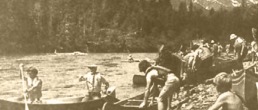The High Ross Treaty
In 1942, Seattle City Light negotiated an agreement with the Province to raise the dam by 120 feet which would have flooded over 5,000 acres of prime wildlife habitat and recreation lands in BC. The Agreement was upheld by the Provincial Government in 1967 but generated intense opposition. Lengthy negotiations ensued.
In the 1984 Treaty, Seattle City Light agreed not to raise Ross Dam for 80 years in exchange for power purchased at rates equivalent to what would have resulted from raising the dam.
The High Ross Treaty also created the Skagit Environmental Endowment Commission (SEEC) to manage an endowment fund to preserve the area, pristine wilderness and fish and wildlife habitat in the Upper Skagit Watershed until 2065.
Treaty Between the United States and Canada with Complete Text of:
Appendix A Technical Arrangements
Appendix B High Ross Cost Estimates
Appendix C Dispute Resolution Procedures
Appendix D Agreement between British Columbia and Seattle Creating SEEC
Appendix E: Report on Agreement
The Purpose of SEEC
Text from the High Ross Treaty, 1984
To conserve and protect wilderness and wildlife habitat.
To enhance recreational opportunities in the Skagit Valley.
To acquire mineral or timber rights consistent with conservation and recreational purposes.
To conduct studies of need and feasibility of projects.
To plan for and construct hiking trails, footbridges, interpretive displays and the like.
To cause the removal of stumps and snags in Ross Lake and on the shoreline as deemed appropriate, and the grooming and contouring of the shoreline, consistent with wildlife habitat protection; and
To connect, if feasible, Manning Provincial park and the North Cascades National Park by a trail system.
Canoeists at the International “Canoe-In” on July 28, 1974.
46 canoes and 20 kayaks successfully negotiated the river!
